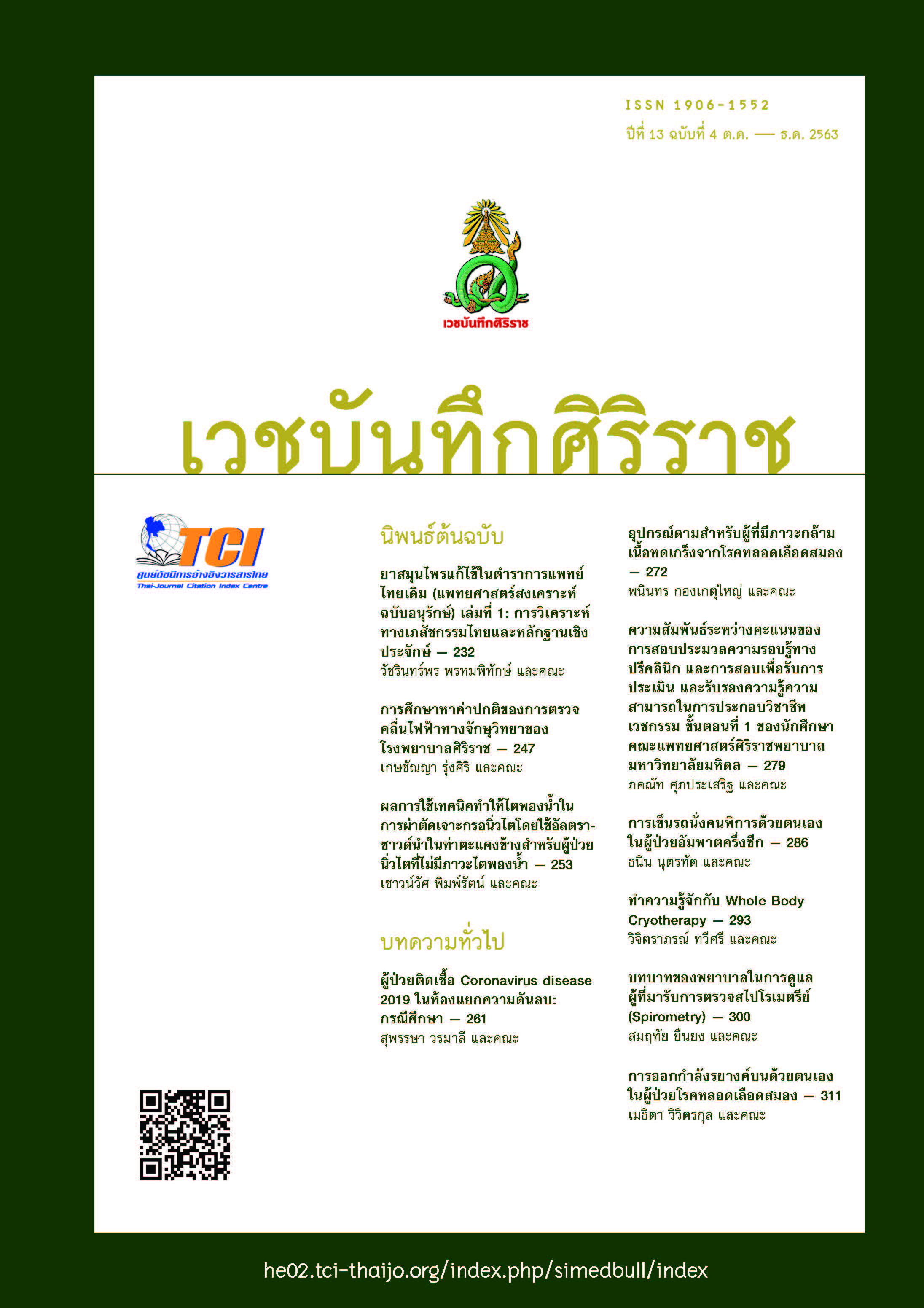Patients Infected with Coronavirus Disease 2019 in Negative pressure rooms: Case Study
Main Article Content
Abstract
The situation of the outbreak of coronary virus 2019 (COVID -19) that is spread rapidly in many countries around the world resulting in a large number of people infected and dying. As of March 11, 2020, the World Health Organization announced that COVID-19 is a pandemic which the number of patients has increased a lot not only new cases are found around the world and increasing by around 3,000-4,000 per day but also there are estimated 200-300 deaths per day. The death rate from this disease is approximately 3.5 percent. Most are the elderly, smokers and people with chronic illnesses such as heart disease and diabetes, which in Thailand has a constant infection. So, Thailand Centers for Disease Control announces new strain of coronary virus disease 2019 as dangerous communicable disease According to the Communicable Disease Act 2015 and coming into effect on March 1, 2020.
This article is a report on patients diagnosed with COVID-19 with the detection of genetic material from secretions within the nasal cavity and throat by Real Time Polymerase Chain Reaction (RT-PCR). And treated with medicine as well as comparing other patients who have been taken care of by placing them in a negative air pressure room and periodically checking for genetic material from secretions in the nasal cavity and throat until no infection is found.
Article Details
References
2. Cheng ZJ et al. 2019 Novel Coronavirus: where we are and what we know. Infection. 2020 Feb 18. doi: 10.1007/s15010-020-01401-y. [Epub ahead of print] Review.
3 Ji W, Wang W, Zhao X, Zai J, Li X. Homologous recombination within the spike glycoprotein of the newly identified coronavirus may boost cross-species transmission from snake to human. J Med Virol 2020;92(4):433-40.
4. Department of Disease control [Internet]. [cited 2020 Mar 1]. Available from:https://ddc.moph.go.th/viralpneumonia/file/situation/situation-no57-290263.
5.คู่มือป้องกันโรคโควิด-19. (2020). คณะกรรมการสุขภาพแห่งมณฑลยูนนาน มหาวิทยาลัยการการแพทย์คุนหมิง สำนักพิมพ์การศึกษายูนนาน.
6. Wang C, Horby PW, Hayden FG, Gao GF. A novel coronavirus outbreak of global health concern. Lancet. 2020 Feb 15;395(10223):470-3.
7.World Health Organization. Coronavirus situation South-East Asia Thailand . www.who.int › Health-topics.
8.Centers for Disease Control and Prevention. Symptoms of Coronavirus 2019.http://www.cdc.gov>2019-ncov
9. Liang H1, Acharya G. Novel corona virus disease (COVID-19) in pregnancy: What clinical recommendations to follow? Acta Obstet Gynecol Scand. 2020 Mar 5. doi: 10.1111/aogs.13836.
10. การเตรียมความพร้อมด้านการรักษาพยาบาลและป้องกันการติดเชื้อในโรงพยาบาล Covid-19, March 5, 2020. Available from: https://ddc.moph.go.th/viralpneumonia/file/g_km/km10_120363.pdf (accessed March 18, 2020)
11.คณะกรรมการกำกับดูแลรักษาโควิด-19.แนวทางเวชปฏิบัติ การวินิจฉัย ดูแลรักษา และป้องกันการติดเชื้อในโรงพยาบาล กรณีผู้ป่วยติดเชื้อไวรัสโคโรนา 2019 (COVID-19) . ฉบับปรับปรุง วันที่ 21 มีนาคม พ.ศ. 2563.
12.Tingbo LIANG (2020).Handbook of COVID-19 Prevention and Treatment :Zhejiang University School of Medicine.
13.การปฏิบัติตัวระหว่างการกักกัน หรือคุมไว้สังเกตในที่พักอาศัย. Available from: https://ddc.moph.go.th/viralpneumonia/file/int_protection/int_protection01.pdf (accessed March 20, 2020)
14. WHO. Clinical management of severe acute respiratory infection (SARI) when COVID- 19 disease is suspected Interim guidance 13 March 2020.
15. Centers for Disease Control and Prevention (CDC). Interim Considerations for Infection Prevention and Control of Coronavirus Disease 2019 (COVID-19) in Inpatient Obstetric Healthcare Settings. Available from: https://www.cdc.gov/coronavirus/2019- ncov/hcp/inpatient-obstetric-healthcare-guidance.html. (accessed March 19, 2020)


